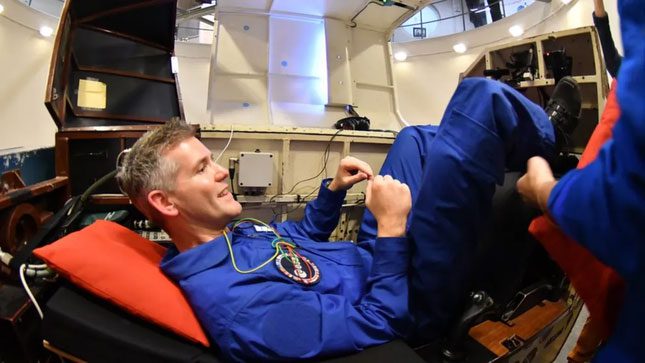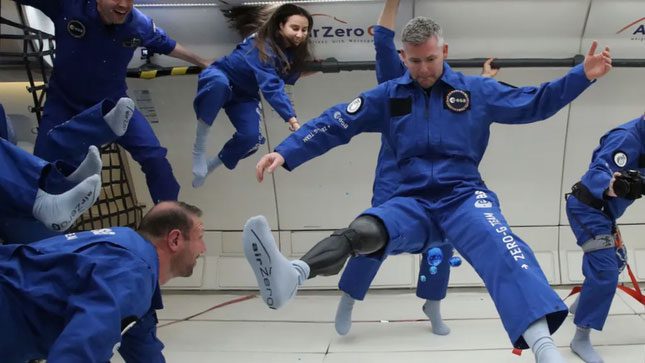Former Paralympic athlete John McFall is collaborating with the European Space Agency (ESA) in a groundbreaking study to explore whether people with disabilities can live and work in space.
This is a challenge that any aspiring astronaut must face. It is certainly not for the faint-hearted or those who fear confined spaces. With a loud clang, the door slams shut, trapping John McFall in the darkness of a metal box.
The filming begins. He is inside a massive centrifuge, spinning continuously to simulate the extreme gravitational forces (G-forces) of a rocket launch. “The faster it spins, the higher the G-force,” John explains. “Today, we will ramp it up to about 6 G—six times the force of gravity. It recreates what happens when you re-enter the atmosphere.”
This experiment is part of John’s training program with the European Space Agency. In 2022, he was selected as the first disabled astronaut candidate to investigate whether he could safely go to space. John is a below-knee amputee; he lost the lower part of his right leg in a motorcycle accident when he was just 19 years old. He typically wears a high-tech prosthetic leg but removed it to assess the impact of the centrifuge on his calf.
ESA surgeon Maybritt Kuypers is responsible for monitoring him. “This is the first time we have had an amputee in the centrifuge. Essentially, the astronaut lies back in a seated position, which will affect blood flow, including in the legs. We are curious to see how it affects him, but so far, everything has gone very well,” she stated.
John has temporarily paused his career as an orthopedic surgeon to embark on astronaut training, moving from the UK to the European Astronaut Centre in Cologne, Germany. Although he is not guaranteed a flight into space, this research will examine the requirements to make that a reality—spacecraft, spacesuits, and various types of prosthetics.
Currently, John is evaluating his running leg. A former Paralympic sprint athlete and medalist, sports are a significant part of his life. Maintaining fitness in space is crucial for preserving muscle mass and bone density.
Now, John is using a special anti-gravity treadmill that helps recreate the conditions of weightlessness on the International Space Station (ISS). A stream of air lifts him up, making him feel lighter. However, because the treadmill reduces his weight by about 80%, his prosthetic leg is not functioning optimally. “I find that my foot is too stiff. That’s because I am lighter and putting less force on my foot, so it bends less, resulting in less elasticity,” he said.
He believes he needs a more flexible prosthetic leg, but the story doesn’t end there. During a parabolic flight last year, when John first experienced weightlessness, he realized that his high-tech prosthetic would need adjustments. In fact, John thinks he might need several prosthetics on the ISS. “There will be a running prosthetic, a backup processor, and even a mechanical prosthetic that can be worn inside the spacesuit during launch and re-entry. I will need a prosthetic storage unit,” he said.
ESA is the first space agency to undertake such a project. Until now, John’s disability might have barred him from becoming an astronaut, but Frank De Winne, head of the European Astronaut Centre, wants to change that. “We think this is a fantastic opportunity because we have so much extraordinary talent—people with disabilities like John. Why not try to nurture this talent for great missions like becoming an astronaut?” he remarked.

John McFall preparing in the centrifuge.
Moving to Germany has been a significant change for his wife, Sonia, a former Olympic gymnast, and their three young children, Fin, Isla, and Immy. Gathered around the dinner table, they discuss their father’s new job. Their eldest son, Fin, cannot believe that his dad has changed careers from being a doctor to a job that could “take him into the dark void” of space.
Sonia believes that John’s new career is a perfect fit for him. “In our family, it’s important to seize every opportunity. For me, this is an opportunity that he has successfully embraced. I hope he will be rewarded appropriately, which means going to space and showing everyone that it is possible,” she said.

A parabolic flight gave John the chance to assess his prosthetic.
Back in the centrifuge, John gives a thumbs up as he steps out of the machine. “It was amazing. And you know what? I didn’t even notice my right leg throughout the whole process. That was probably the part that made me feel the most comfortable, and it’s really helpful for this research,” he said with a big smile.
John has completed half of the project and has yet to find any factors that could hinder the mission. “I hope it will broaden people’s perspectives and knowledge about the capabilities of a person with a disability. But I also hope that they will just see me as John. Because I’m just John, I want to be an astronaut, and at the same time, I have a physical disability. This is the message we are trying to convey,” he concluded.


















































